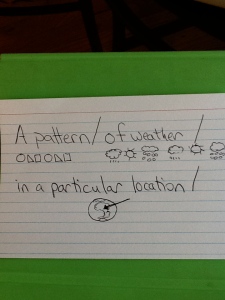Suggestions for Curricular Vocabulary Challenges

Deena shared some great techniques last week regarding vocabulary cards, which works for lots of students. I would like to share with you how we help our students with curricular vocabulary that have linguistically complex definitions. I have offered workshops in the Baltimore area for tutors and parents who want to help their students more effectively “anchor” curricular definitions. We’re so excited to have this opportunity to share on a broader basis!
So many of our middle school clients approach studying in this manner: pull out the index cards, “memorize” the definitions on the back, play a matching game or two with the index cards, then feel they are ready to take the big test. If the teacher “re-frames” the definition on the test, students with learning-disabilities often do not see that the “test” definition is equivalent to the one they memorized, it reads like a foreign language. We see this over and over in our practices. Big effort expended, little dividend to show for it. The frustration mounts…
Students with language-based learning disabilities often have difficulty with the grammar of the language, and/or with linguistic flexibility. Students tend to focus in on “fragments” of definitions, often missing the overarching meaning (Scott and Nagy 1997) Or, they master the “gestalt” of the concept but fail to recognize the components of the definition if they are not presented in the exact terms they had committed to memory. During our speech-language sessions, it is not our job to ensure the student is “ready” for the test, but we use the student’s scholastic materials to teach vital strategies so that they can overcome this. We will walk you through one of our techniques using a recent example.
A 5th grade boy (we will call him John) came to me with a dozen or so geography terms he had to memorize. I will use “Climate” to show the process I used with him. He had been asked to memorize the definition, “A pattern of weather in a particular location over a specified amount of time“.
First, we discussed his background knowledge of the concept of climate. Like many students with whom Deena and I work, he was a bright boy who had absorbed the concept during class after discussions, watching film and engaging in class activities. Under the word CLIMATE, the teacher had asked the students to draw a quick picture of something that would trigger the idea of climate. He had drawn a sun. (Aside: I have seen this improvement in recent years–teachers are really getting the idea that visuals can help anchor information!) I take a slightly different approach, however. Because it is often difficult to draw one “quickie” picture that is meant to capture all aspects of the definition, I prefer to focus our artistic attention to the phrases within the definition, and address the word in a different way.
Secondly, on the flip side of the index card, I divided the definition into segments that represent concepts, like this:

The Third step is to add a visual representation of each phrase that was bracketed, like this:

This process went something like this. While I was drawing the shapes, I asked John to stop me when I had actually made a “pattern”. He stopped me the second I completed my last square. He understood the concept of “pattern”. John transferred the picture concept to his index card under the phrase “A pattern” and I asked him, “But are we talking about a pattern of shapes?” “No, a pattern of weather!” “OK, so we should draw something similar, but use weather pictures instead of shapes.” He drew a raincloud, sun and snow, repeated and knew he was done.
I repeated the process for “in a particular location”

This shows the completed card:

As I was drawing the “timeline” to represent the final concept, I asked him to direct me, and tell me when I was finished/how many years were passing. The term “specified” means someone is in charge of stating how long that time period is (weather experts). I wanted him to understand that, so I stopped the timeline when he told me to.
Once the index card was complete, the “language portion” of the program began. The next step was to ensure that John understood that the picture concept that we had drawn for each component could be explained using a variety of language:
“pattern of weather” could be:
weather that repeats
repeating weather
cycle of weather
prevailing weather conditions (slightly different meaning, but could be substituted on a test)
“in a particular location” could be:
in a specific place
in a specific location
in a place
in a region
in an area
somewhere
John needed to see that the definition for Climate could be:
“Over a long period of time, when weather repeats in a region”
or
“When there is a prevailing weather condition in a certain place on the globe”
Teaching linguistic flexibility is a necessity for our students. We have experienced great success with our students using this technique! If I ask my students (and their parents) nicely, I am sure we could upload several other examples of these curricular cards if the interest is out there!
Hope that helps,
Beth

